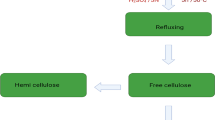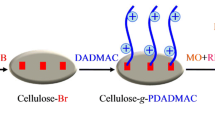Abstract
In this study, regenerated cellulose membrane was used as a filter in liquid-phase polymer-based retention technique. The poly(4-vinyl-1-methylpyridinium bromide), P(BrVMP), was used as extracting reagent of As(V). The role of pH, polymer:As(V) molar ratio, and influence of regenerated cellulose membrane were investigated by washing method. It was observed that the efficient retention was obtained at pH 9 with 20:1 polymer:As molar ratio and it was about 100 % at Z = 10 for P(BrVMP). Experimental data showed that the regenerated cellulose membrane, compared to poly(ethersulfone) membrane, has a capacity to interact with As(V). The maximum retention capacity of P(BrVMP) was determined by enrichment method, and then, using alternately washing and enrichment methods, the charge–discharge process and recovery of P(BrVMP) were performed.








Similar content being viewed by others
References
Leist M, Casey RJ, Caridi D (2000) The management of arsenic wastes: problems and prospects. J Hazard Mat 67:125–138
Sánchez J, Rivas BL (2011) Arsenate retention from aqueous solution by hydrophilic polymers through ultrafiltration membranes. Desalination 270:57–63
Harper TR, Kingham NW (1992) Removal of arsenic from wastewater using chemical precipitation methods. Water Environ Res 64:200–203
Kabay N, Bundschuh J, Hendry B, Bryjak M, Yoshizuka K, Bhattacharya P, Anac S (2010) The global arsenic problem: challenges for safe water production. CRC press, Taylor and Francis Group, Leiden
Johnston R, Heijnen H (2001) Safe water technology for arsenic removal. In: Feroze Ahmed M, Ashraf Ali M, Zafar A (eds) Technologies for arsenic removal from drinking water. Bangladesh University of Engineering and Technology, Dhaka, pp 1–22
Mohan D, Pittman CU Jr (2007) Arsenic removal from water/wastewater using adsorbents—a critical review. J Hazard Mat 142:1–53
Rivas BL, Aguirre M, Pereira E (2007) Cationic water-soluble polymers with the ability to remove arsenate through an ultrafiltration technique. J Appl Polym Sci 106:89–94
Polowczyk I, Bastrzyk A, Koźlecki T, Sawiński W, Rudnicki P, Sokołowski A, Sadowski Z (2010) Use of fly ash agglomerates for removal of arsenic. Environ Geochem Hlth 32:361–366
Rivas BL, Pereira E, Paredes J, Sánchez J (2012) Removal of arsenate from ionic mixture by anion exchanger water-soluble polymers combined with ultrafiltration membranes. Polym Bull 69:1007–1022
Bayer E, Geckeler K, Shkinev V, Vorob’eva G, Spivakov B (1986) Methode zur Arsen-Dekontamination von wassrigen Losung.//Offenlegungsschrift DE 3637643 A 1. Aktenzeicen P 3637643.4. 5.11.86. Offenlegungstag 11.05.88
Rivas BL, Pereira ED, Moreno-Villoslada I (2003) Water-soluble polymer-metal ion interactions. Prog Polym Sci 28:173–208
Rivas BL, Pereira E, Palencia M, Sanchez J (2011) Water-soluble functional polymers in conjunction with membranes to remove pollutant ions from aqueous solutions. Prog Polym Sci 36:294–322
Barron R, Fritz J (1984) Effect of functional groups structure on the selectivity of low capacity anions-exchangers for monovalent anions. J Chromatogr 284:13–25
Wei YT, Zheng YM, Chen JP (2011) Functionalization of regenerated cellulose membrane via surface initiated atom transfer radical polymerization for boron removal from aqueous solution. Langmuir 27:6018–6025
Sánchez J, Rivas BL (2010) Arsenic extraction from aqueous solution: electrochemical oxidation combined with ultrafiltration membranes and water-soluble polymers. Chem Eng J 165:625–632
Acknowledgments
The authors thank to 7FP-MC Actions Grant so-called CHILTURPOL2 (PIRSES-GA-2009 Project, Grant Number: 269153) for a fellowship to Dr. A. Bastrzyk to do research at University of Concepcion, Chile. The authors are also grateful for Grants FONDECYT (No 1110079) and PIA (Grant Anillo ACT 130) for financial support. Julio Sánchez thanks also FONDECYT (postdoctoral Grant No 3120048) and CIPA.
Author information
Authors and Affiliations
Corresponding author
Rights and permissions
About this article
Cite this article
Sánchez, J., Bastrzyk, A., Rivas, B.L. et al. Removal of As(V) using liquid-phase polymer-based retention (LPR) technique with regenerated cellulose membrane as a filter. Polym. Bull. 70, 2633–2644 (2013). https://doi.org/10.1007/s00289-013-0979-z
Received:
Accepted:
Published:
Issue Date:
DOI: https://doi.org/10.1007/s00289-013-0979-z




